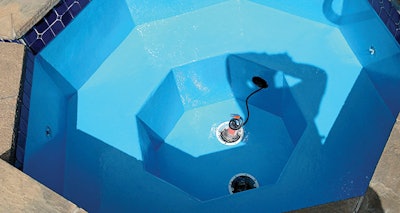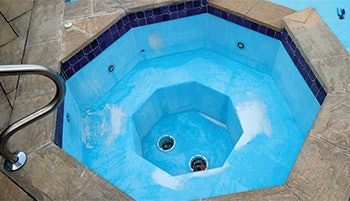 Photos courtesy All Seasons Pools and Spas
Photos courtesy All Seasons Pools and Spas
We are in the midst of a dramatic increase in demand for pool renovation, part of a larger movement — a worldwide rediscovery of the backyard's potential as a base for modern life. As homeowners look to upgrade their pool surface, they face choices: Deteriorated plaster or fiberglass pools can be re-plastered or re-finished; however, this takes time and can be costly. More importantly, it takes skilled labor that is in short supply in the new pandemic-affected pool economy.
Painting those pools could be a better solution. In addition to brightening the color, a new coat of paint can be a cost-efficient way to give new life to and protect concrete, plaster or fiberglass pool surfaces — even pool decks. There are now many paint coating options for virtually any pool or deck surface. Choosing the right product — be it epoxy, rubber or acrylic paint — is key. Now is the time to embrace specialty pool coatings, so you can help your clients save time and money renovating their pool and deck.
RELATED: Pool finishes stay beautiful when salt water stays balanced
 Before and after photo set of a custom spa paint job. Note the repair and prep work on the before photo (below). In the after photo (above), the light fixture has been removed to allow for good coverage around the niche.
Before and after photo set of a custom spa paint job. Note the repair and prep work on the before photo (below). In the after photo (above), the light fixture has been removed to allow for good coverage around the niche.

Getting Started
Many pool professionals feel a bit overwhelmed choosing the best paint for the job, as no one wants to purchase the wrong paint for the application. It's important to understand that there are generally three types of pool coatings to choose from, each with their pros and cons, based on the pool into which it will be applied.
Rubber-Based Paints – Pros and Cons
PROS: The most commonly used pool coatings are the rubber-based paint types, either chlorinated or synthetic rubber. These are relatively inexpensive and are easy to apply. Chlorinated rubber coatings provide excellent hiding, protection and coverage for previously painted chlorinated rubber surfaces. They can also be applied to bare concrete, marcite or plaster. These finishes are designed to last between four and five years.
Synthetic rubber coatings can be applied over existing chlorinated or synthetic rubber systems, bare concrete or plaster, and are intended for use where adherence to volatile organic compound regulations is compulsory. When properly applied, this finish can last up to three years.
CONS: Although popular, these coatings do have some disadvantages that might affect the choice to use rubber-based paint for renovation. They do require a bone-dry surface at the time of application. As busy pool professionals know, at times, this may not be possible. Additionally, the pool will need five to seven days of curing time before water can be added to the pool. These paints can also "blister" if they are applied during really hot weather — particularly if you are renovating a previously painted pool surface. Finally, rubber-based paints contain strong and volatile solvents which can induce headaches and nausea at the time of application. So clearly there are circumstances that make rubber-based paints less attractive for pool renovations.
Epoxy Coatings – Pros and Cons
PROS: Epoxy coatings create a tough, durable finish with unsurpassed stain, chemical and abrasion resistance. Epoxy can be an excellent alternative to re-plastering; two coats of a high-build epoxy will achieve a tough, abrasion-resistant surface that costs two-thirds the price of expensive resurfacing finishes. With proper preparation, a high-build epoxy finish can last up to eight years. Traditional epoxy will last approximately five years.
CONS: Only an epoxy coating can be applied over an epoxy coating. Solvent-based epoxy coatings cannot be applied over chlorinated rubber, synthetic rubber or acrylic coatings. Epoxy coatings also require an epoxy primer on uncoated surfaces — however, when recoating an existing epoxy coating in good condition, primer is not necessary. Remember to also consider self-priming paints that will reduce the amount of time needed to complete the job and save money by avoiding the purchase of a primer. These paints eliminate the need to apply a primer before applying the first layer of paint.
Water-Based Acrylics – Pros and Cons
PROS: Water-based acrylic paints are environmentally safe and user-friendly. They can be applied on damp surfaces without causing blisters in the paint. Additionally, this type of coating does not contain strong solvents and can be applied over most types of coatings — providing they are in sound condition. Most importantly, this is a very cost-effective painting approach when done correctly. Water-based acrylics are the best choice for indoor pool renovations as they don't contain noxious solvents, making them superior for enclosed environments.
CONS: Although easier to apply, acrylic paints tend to only last one or two seasons of use, so it's important to point that out to the customer. Water-based acrylic paints can also be problematic when you are renovating a previously painted pool — particularly if the pool was previously painted with an epoxy paint, as acrylic will not work over epoxy. This makes it very important to run a paint-chip analysis from the surface of the pool before selecting the best coating to use.
 Photos courtesy RAMUC Specialty Pool Coatings
Photos courtesy RAMUC Specialty Pool Coatings
Paint Selection
Paint selection begins by determining what type of coating is currently on the pool. Unfortunately, with many pools, pool professionals must deal with a pool that has many, many layers of built-up paint. Some pools even have more than one type of paint under the various layers. Some pool paint suppliers offer a free paint chip analysis, which can be very helpful, especially with pools that have many layers of old paint. To prevent an expensive mistake, a paint chip should be sent to the paint supplier for analysis, as they can provide information such as thickness, number of coats present and integrity of adhesion, as well as make recommendations for the best paint to use in the particular pool application.
Inspect, Scrape, Repair and Clean Before Painting
Whatever type of coating is being used, it will adhere best to a solid and clean surface. Preparing the surface before beginning to paint is very important. Be sure to scrape any peeling, flaking or chipped paint and sand smooth in addition to repairing any minor cracks or chips.
RELATED: How Painting is Like Retailing
Cleaning the pool surface before painting is also very important. The pool surface should be free of loose paint, dirt or oils. There are products designed specifically for pool surface preparation and using them is highly recommended. In most cases, these products can reduce the amount of time needed to clean the pool's surface, allowing the job to be completed with just one step in one-third the amount of time.
Applying the Paint
When applying the pool coating, it is important to adhere to the recommended coverage. Paint that is applied too thin will not provide adequate coverage or yield a long-lasting result; whereas a thick coat may cause air bubbles, "alligatoring" or blistering.
Temperature matters. Pool professionals should avoid painting if the temperature is below 50 degrees Fahrenheit, above 85 degrees Fahrenheit, or if the overnight temperature will drop below 50 degrees Fahrenheit. If the temperature is above 85 degrees Fahrenheit, the paint can blister. Temperatures under 50 degrees Fahrenheit will cause the paint formula to become more viscous or thickened, making it difficult to apply evenly. Pool paints are designed to dry and cure within a defined temperature range. The chemicals that make up the paint require the proper temperature to bond together and adhere to the surface. If the paint is not able to cure, then uneven coverage, peeling, bubbling, cracking and other problems can occur.
In addition, do not paint in direct sunlight as it will affect adhesion, primarily because it causes the paint to dry too quickly. The solvents in the formula will not be able to evaporate properly and result in adhesion failure. High temperatures can cause the paint to bubble and blister, which results in peeling once it cures.
Once the painting is complete, be sure to allow for adequate drying time (specified on the product label). Some pool professionals may be eager to refill the pool once they have finished painting the surface, so it can be opened quickly for use. However, allowing for adequate drying time is the last step to a successful pool paint application.
Faster Renovations and Less Pool Maintenance
Painting pools is one of the most economical ways to keep them looking good and performing well. Additionally, clients will find that maintaining their newly painted pool and deck will be easier to maintain after renovation. The first step is to get those paint chip samples in for analysis. Once you know what paint is currently on the pool's surface, work with your local paint supplier to help choose the most appropriate option for repainting a pool or deck quickly and successfully to give your clients a much-needed upgrade to their swimming and outdoor living experience. ~
Kevin Harrington is the President of the Ramuc Pool Paint Company, located in Rockaway, N.J. Harrington has vast product knowledge of coatings, the result of more than than 41 years of experience in the industry. He can be reached via email at [email protected].
This article first appeared in the January 2021 issue of AQUA Magazine — the top resource for retailers, builders and service pros in the pool and spa industry. Subscriptions to the print magazine are free to all industry professionals. Click here to subscribe.







































